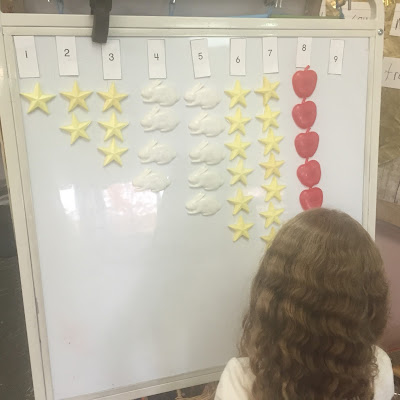If you are old enough to remember a program called Math Their Way, then you might remember “tubbing time.” Last year, I created a set of math tubs for each module of our math program that was organized in a similar fashion to the tubs in that program. The advantage of this system is that the manipulatives for each of the tubs stays the same, but the task changes with the introduction of each new math unit. So the children are using pattern blocks, snap cubes, geoboards and other manipulatives to explore number, geometry, measurement, etc. This has simplified the storage of the centers since the bulky manipulatives stay in the tubs throughout the year and only the task cards need to be stored elsewhere when not in use.
.
Here is where the tubs are stored. I have two of these shelving units and they are secured back-to-back so kids can easily access them. Each tub has a number that correlates to a work space in our classroom.
The children use these tubs at the beginning of our day after they complete their morning jobs. In the first round, they are allowed to free explore the manipulatives. Currently, they are working with the number 1-10 tubs. They may work in these tubs for several rounds until I begin to slowly introduce the tasks for the next unit, which is geometry. Here are some pictures of my students working with the number tubs.
The kids really enjoy working at these tubs and it gives me a few minutes at the beginning of the day to pull students for assessments or interventions.
Thanks for stopping by!
The children use these tubs at the beginning of our day after they complete their morning jobs. In the first round, they are allowed to free explore the manipulatives. Currently, they are working with the number 1-10 tubs. They may work in these tubs for several rounds until I begin to slowly introduce the tasks for the next unit, which is geometry. Here are some pictures of my students working with the number tubs.
Snap Cube Staircases from First Grade Blue Skies
Birthday Cake Counting Mats from Twinkl
Pattern Block Numbers from Making Learning Fun
Magnetic Chip Numbers from Tot School
Magnet Board Staircases
Play dough Numbers/Sets from Homeschool Creations
Ipads - Line 'em Up App from Classroom Focused Software
Truck Counting Mats from The Measured Mom
Geoboard Numbers from Making Learning Fun
Pattern/Design Numbers
Treasure Box Numbers from Confessions of a Homeschooler
Thanks for stopping by!
Jackie




















